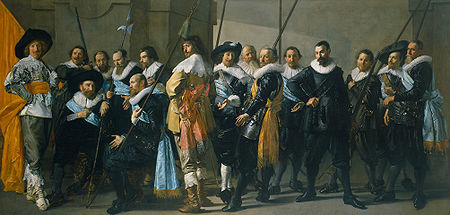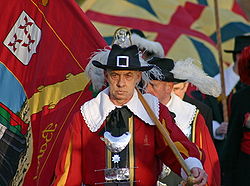- Schutterij
-
 The Amsterdam archery militia whose patron saint was St. Sebastian, in 1653 by Bartholomeus van der Helst
The Amsterdam archery militia whose patron saint was St. Sebastian, in 1653 by Bartholomeus van der Helst
Schutterij (German: Schützenverein) refers to a voluntary city guard or citizen militia in the medieval and early modern Netherlands, intended to protect the town or city from attack and act in case of revolt or fire. Their training grounds were often on open spaces within the city, near the city walls, but, when the weather did not allow, inside a church. They are mostly grouped according to their district and to the weapon that they used: bow, crossbow or gun. Together, its members are called a Schuttersgilde. It is now a title applied to ceremonial shooting clubs and to the country's Olympic rifle team.
Contents
Function
The schutterij, civic guard, or town watch, was a defensive military support system for the local civic authority. Its officers were wealthy citizens of the town, appointed by the city magistrates. In the Northern Netherlands, after the formal changeover in civic authority after Beeldenstorm, which depending on the town, was sometime between 1566 and 1580, the officers had to be a member of the Dutch Reformed Church. Its captain was usually a wealthy inhabitant of the district, and the group's ensign was a wealthy young bachelor (often recognizable in group portraits of Schutterijen by his particularly fine clothes and the flag he is carrying). Joining as an officer for a couple of years was often a stepping-stone to other important posts within the city council. The members were expected to buy their own equipment: this entailed the purchase of a weapon and uniform. Each night two men guarded their district in two shifts, from ten till two, and from two till six, closing and opening the gates of the city. At a set time each month, the schutters would parade under the command of an officer.
The ideal was that, for every hundred inhabitants, three would belong to the schutterij. The Dutch Mennonites were excluded from a position in the schutterij in the 16th, 17th and 18th centuries and paid a double tax in lieu of service. Roman Catholics were permitted in the lower regions. Persons in the service of the city (such as the minister, the city-physician, the teacher, the sexton, the beer-bearers and peat bearers), and the city's Jews, did not need to serve. The beer and peat bearers had to serve as the town's firefighters instead.
 De Magere Compagnie ("The Meagre Company"), a schutterstuk for one of the Amsterdam guilds by Frans Hals and Pieter Codde, painted in 1633-37.
De Magere Compagnie ("The Meagre Company"), a schutterstuk for one of the Amsterdam guilds by Frans Hals and Pieter Codde, painted in 1633-37.
Training grounds
The schutters (traditionally archers) or cloveniers (musket bearers) met at target practice grounds called Doelen (targets). These fields were generally adjoining a large building where they met indoors for gymnastic exercises and held their meetings. It was in these great halls where the large group portraits hung for centuries, and many paintings suffered dramatically from enthousiastic gymnasts over the years. These locations were not the only place the schutters met each other. These guilds also kept altars in local churches, where they met for religious reasons. Most schutterij guilds had as patron saints Saint Sebastian, Saint Anthony, Saint George (St. Joris in Dutch), or Adrian of Nicomedia (St. Adriaen in Dutch). These religious duties were a significant part of the guild membership, since that is also where they paid their dues. After the Protestant Reformation, all the altars were disbanded in the Dutch Reformed churches in the Northern Netherlands, and membership dues were no longer paid in church, but at the city hall. In Amsterdam, the guilds were no longer allowed to make rules or spend money on their own, but in Haarlem there were two guilds who kept their original rules (St. Adriaen and St. Joris), such as holding banquets and collecting for sick members or widows. Though they moved premises several times, some of the old Haarlem Doelen halls still stand where the schutters met and where their group paintings hung, though now these paintings are all preserved carefully now in the Frans Hals museum.
-
Meeting hall of the Cloveniers, now the Haarlem Public Library, with a commemorative plaque above the door, placed 200 years after the Siege of Haarlem, when many Cloveniers died defending the city.
-
Group portrait by Hendrik Gerritsz Pot, 1630, on what is now library steps. Through the window one sees the study hall ceiling.
Above the door - In 1572 the Spanish enemy came here to treat us the same way as Naarden.We withstood him, fighting bravely, but from hunger we had to give up.
Schuttersstuk (Dutch Civic Guard group-portraits)
After 1581, the schutterij were officially prohibited from influencing city politics, but since the ruling regency were all members of these guilds, that was quite hard to do. Once a year they held a banquet, with beer and a roasted ox. Whenever a changeover of the leading officers occurred, a local painter was invited to paint the members, and the scene most popularly chosen for these group portraits was the banquet scene. Though occasionally they were shown outside in active duty, the members were usually portrayed for posterity dressed in their Sunday best, rather than their guard dress.
A similar commemorative group painting tradition (the regentenstuk) was true for other Dutch guilds and institutions as well, such as orphanages, hospitals, and hofjes. In the case of the schutterijen, these paintings were called schuttersstukken. After the schutters agreed how they wanted to be depicted together in paint, for such paintings each member paid and posed separately so that each individual portrait within the group was as accurate as possible, and the artist's fee could be paid. An example of just such a schuttersstuk is Rembrandt's Night Watch. This painting is particularly famous for its drama and use of a completely different setting than the traditional banquet, though the reason for that was probably that banquets for guilds had been banned in Amsterdam since 1522.[1] Every member of the schutterij who wanted to be in the group portrait, paid the painter, depending on his position in the painting. According to local legend, the schutterij was unhappy with the result in the Nightwatch case: instead of a group of proud and orderly men, they alleged Rembrandt had not painted what he saw. Ernst van de Wetering declared in 2006 that the Night Watch "... in a certain sense fails ... Rembrandt wanted to paint the chaos of figures walking through each other, yet also aim for an organised composition."[2]
Winning a commission for a schutterstuk was a highly competitive task, with young portrait painters competing with each other to impress members of the schutterij. Often it helped if the painter became a member of the schuttersgilde, and Frans Hals, Hendrik Gerritsz Pot, and Caesar van Everdingen were all members of schuttersgildes who won such commissions. The commission itself was a guaranteed income for a year, but often the painter would win additional commissions to do the rest of the sitter's family, or make a separate copy of the sitter's portrait for private use. The tricky part of fishing for a schutterstuk commission, was that it was never known when a schuttersstuk would be commissioned, since this only happened when one of the leading officers died, retired, or moved away.
An example of a young painter who successfully launched his career in this way is Bartholomeus van der Helst. His selfportrait is in the very painting that was his first schutterstuk commission in 1639 and resulted in a lucrative contract with the Amsterdam Bicker family.
Decline
In 1748 the Doelisten demanded that stadholder William IV allow the bourgeoisie to appoint the militia's officers, but William refused, since in some towns the bourgeois could not even be considered as candidates for these offices. By the second half of the 18th century the schutterij were inactive (sometimes only exercising once a year and with the ill or rich buying their way out of service) and only of importance to Orangists. This brought them much criticism. Translations of the books by Andrew Fletcher and Richard Price became very popular. Patriots tried to breathe new life into the schutterij in 1783 or to create an alternative - in many cities, exercitiegenootschappen (military-exercise societies), vrijcorpsen (free corps) or voluntary schutterijen arose which anybody could join and with officers chosen democratically. The Orangists poked fun at the ministers, like Francis Adrian Vanderkemp propagating the system from the pulpit, and shopkeepers joining the new militia.
The system of schutterijen no longer worked after five hundred years, but survived the French occupation until finally king William I set up professional police forces. In 1901, the schutterijen were abolished.
Reenactment
There are still historical reenactment schutterijen in the Netherlands who honour the old traditions, for instance the schutterij of Geertruidenberg, made up of people who meet regularly to dress in traditional costume and demonstrate how cannons were used in strongholds. Likewise, the Oud Limburgs Schuttersfeest, or the "Old Limburgs Schutter Festival" (OLS) is an annual event in which more than 160 schutterijen (Limburgish: sjötterie) from Belgian and Dutch Limburg compete against each other. The winner organizes the event the following year and takes home "De Um", the highest prize for a schutter.
References
- ^ "Op 27 mei 1522 een verbod gildemaaltijden te houden" in the Amsterdam Archives
- ^ ‘Nachtwacht mislukt meesterwerk’ in the NRC January 7th, 2006
Categories:- Dutch culture
- Dutch words and phrases
- History of the Netherlands
- Dutch Golden Age
- Middle Ages
- Historical reenactment groups
- Militias in Europe
-
Wikimedia Foundation. 2010.







